A Beacon on the Water | Joyce Maynard’s New Hampshire Lakeside Cottage
From 3,000 miles away, a humble New Hampshire lakeside cottage spoke to author Joyce Maynard in the midst of sorrow.
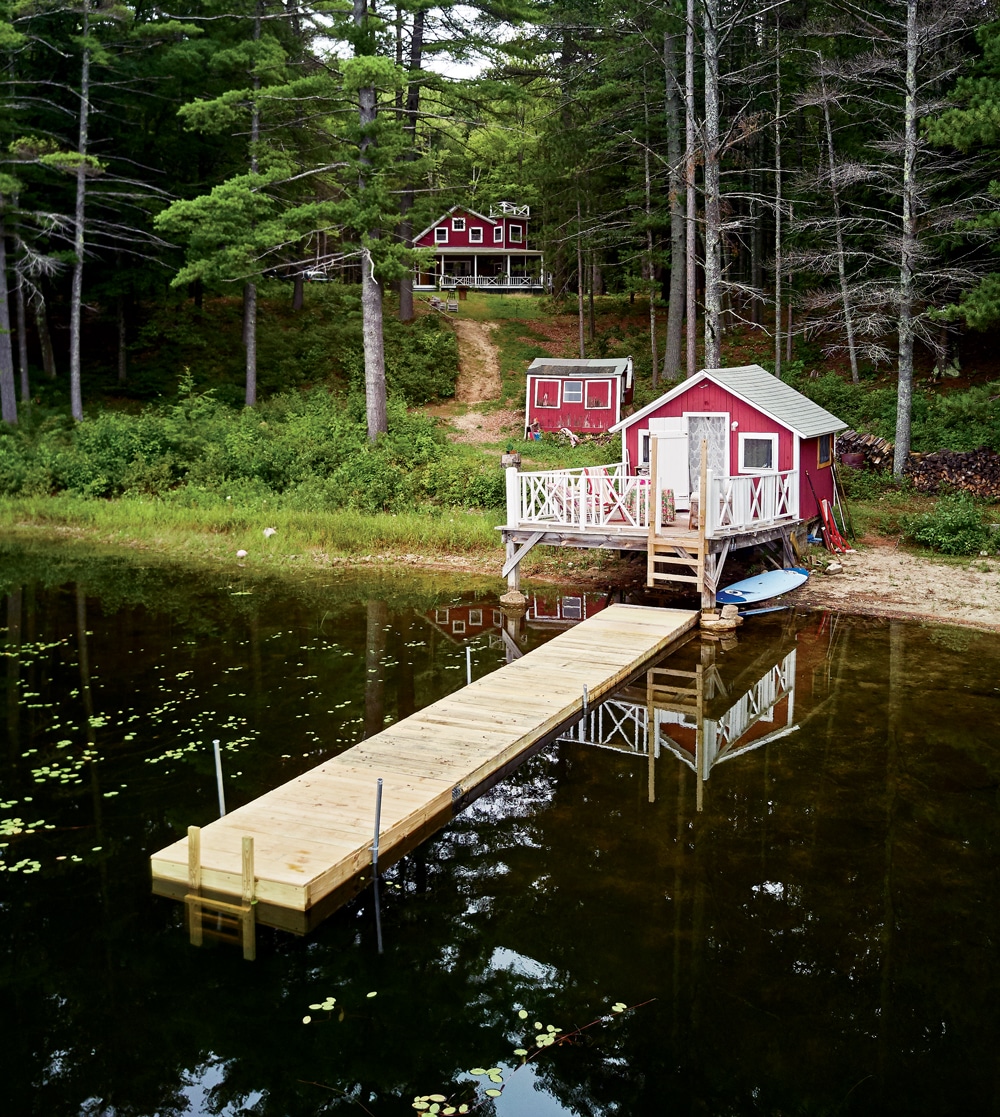
Maynard’s home as seen from the lake. Friends helped convert the shed behind the boathouse into a wood-fired sauna, which she uses almost every night.
Photo Credit : Photographs by Mark Fleming | Styling by Heather MarcusWhen I left my native New Hampshire for northern California at the age of 42, I traded in my down jacket and my Sorel boots and embarked on a love affair with the state. Driving over the Golden Gate Bridge to my new home in Marin County, I never failed to register a little shiver of amazement. I was a small-town girl who skated on ponds, not rinks, and skinny-dipped in swimming holes. What was I doing sitting on the grass in Golden Gate Park taking in a concert? Standing on a beach in Point Reyes and watching the sun come down over the ocean, instead of rising there? Hiking in my T-shirt and shorts in December?
Then I fell in love with Jim, a Midwesterner by birth who’d lived in California since age 4. He’d visited Boston one time, but that was the sum total of his knowledge of the place I still called home. (A place I missed pretty sorely, I had begun to realize. Particularly the part about the seasons. And the part about swimming in natural bodies of water. And the part about roots, and history.)
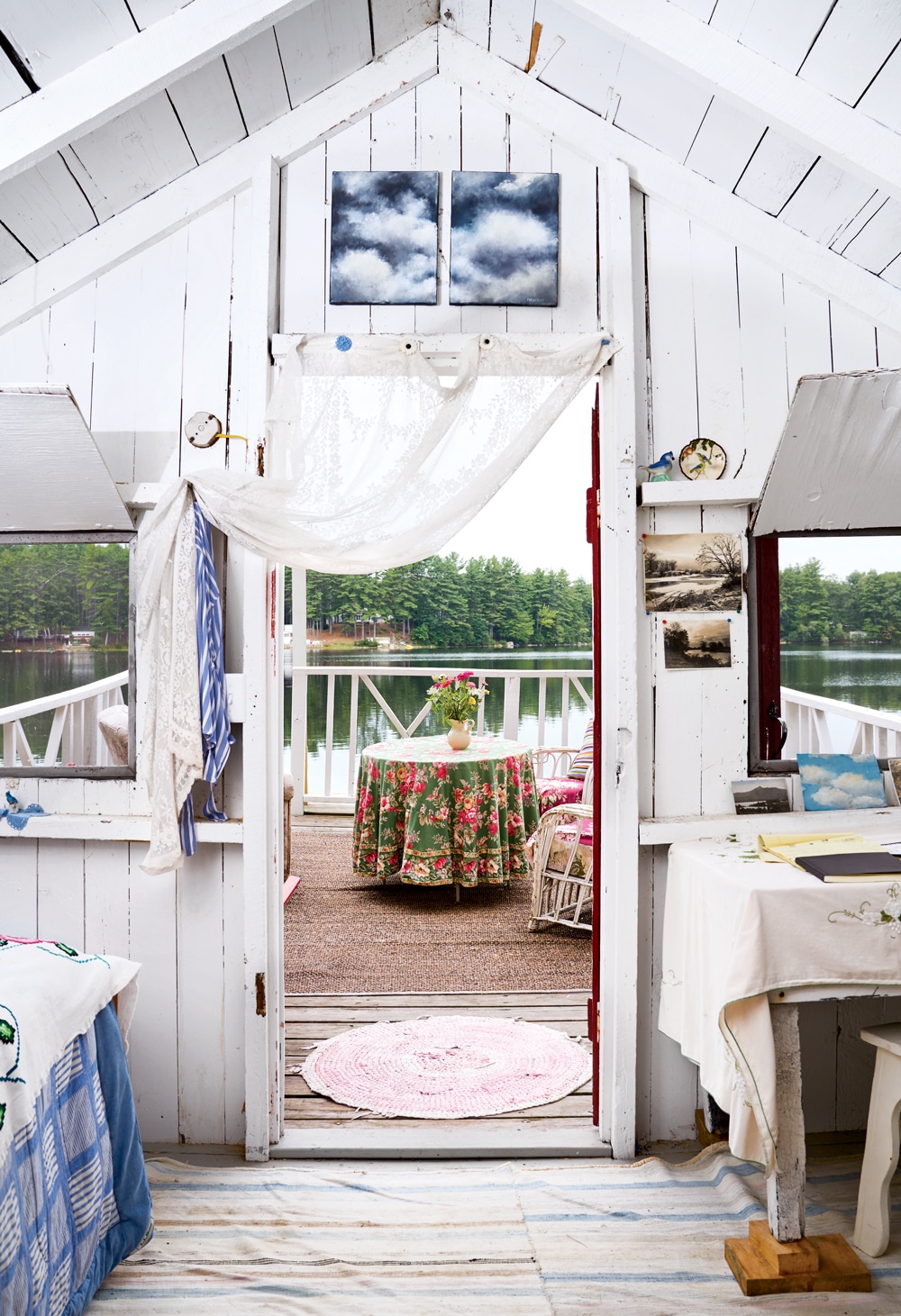
Photo Credit : Photographs by Mark Fleming | Styling by Heather Marcus
One of the things I loved about Jim was his openness to learning about the parts of my life that had come before this one. During our first summer together, he took the only major vacation of his adult life—for the purpose of letting me show him where I came from. We shipped his motorcycle back east, rented a cabin on a lake, and spent the next two months riding the back roads of Maine, New Hampshire, and Vermont. By the end of the summer, Jim had come to love those places the way I did. When we got married the next summer, we held the ceremony on a New Hampshire hillside in one of my favorite towns: Harrisville, a few miles down the road from Mount Monadnock, which I’d climbed at least once every year of my adult life. For our honeymoon we hiked the Presidential Range of the White Mountains.
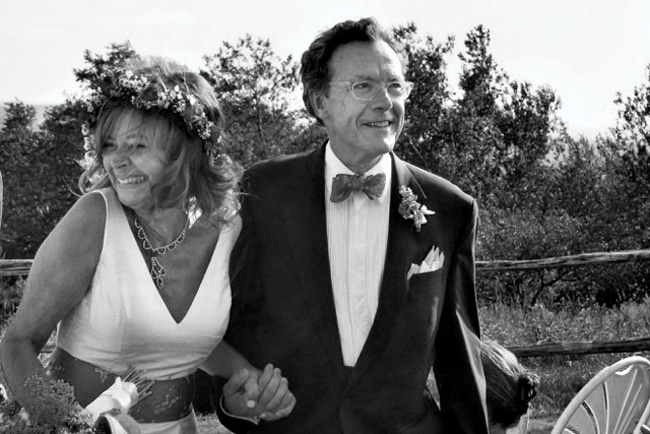
Photo Credit : courtesy of Joyce Maynard
The following summer we returned to New Hampshire, and once again we rented the little lake house where the two of us had enjoyed so many of our happiest times the year before—me in the water, Jim on the dock with his feet up, smoking a cigar. A fishing line in the water, maybe.
Not long after our return home to California—15 months after the wedding—Jim suffered an attack of back pain so bad it sent him to the hospital. The scans he got that day revealed a tumor in his pancreas. The doctor who delivered the news offered little hope.
By the next year, Jim had undergone seven rounds of chemotherapy and a 14-hour surgery, but within months it seemed pretty clear the cancer had come back. By the fall, my husband’s weight was down to 100 pounds and dropping daily. By winter, I knew he was unlikely to make it to another summer. We tried hard to locate moments of joy—and we did—but the knowledge of what lay ahead was sometimes almost too much to bear.
Late that fall, a year into our struggle, I did an odd thing. I created a Google search on my laptop. I typed in the words “lake house New Hampshire.”
It was a fantasy, my search for a lake house. I didn’t say this out loud, but I know where it came from: I was trying to summon an image of beauty, tranquility, and comfort, and the idea of a little cottage on the shore of some body of water I could dive into on a hot summer day. A place, 3,000 miles away, that whispered to me of what I loved, that would endure, and reminded me of the days when Jim was well and our time seemed endless.
A lake house is about as far removed from a hospital waiting room, or an infusion center, as a person can get. When I launched my quest for a lake property, our days were filled with doctor visits and frantic middle-of-the-night trips to the emergency room, and sometimes-weeklong hospital stays. In between there were surgeries and CT scans. I wasn’t going anywhere, but I could dream.
And my dreams always featured a lake.
Within minutes of registering my search, I saw real estate listings begin to show up in my email. Every day a new one appeared—sometimes several. Because I had given no parameters of price to my search (who names the cost of her fantasy, anyway?), the listings I received included multimillion-dollar estates on the shores of Lake Winnipesaukee (I could have been Mitt Romney’s neighbor!) and 4,000-square-foot mansions up north. Those places were so far beyond anything we could afford that even clicking on the listings seemed ridiculous, but there was something comforting in looking at the pictures. Maybe there was even something vaguely reassuring in knowing—when I did this—that I wouldn’t have wanted to spend my summer in any of those places, anyway. The lake house of my dreams wouldn’t feature granite counter tops or air conditioning. Just an old kitchen table and a screened-in porch, with the breeze passing through.
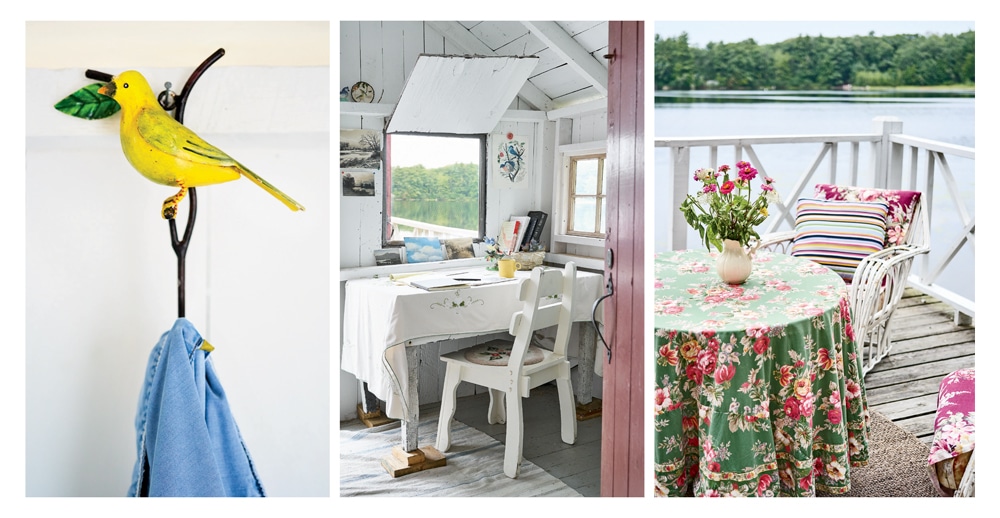
Photo Credit : Photographs by Mark Fleming | Styling by Heather Marcus
Then one day a very different listing showed up in my queue. This house was a lot older than most of the others I’d seen, and the lake on which it sat was a very small one I’d never heard of. Built in 1900, with a wraparound porch—part of it open, part screened in—the house overlooked water that didn’t allow motorboats or Jet Skis (welcome news to a swimmer). The house sat on 2½ acres on a dirt road with only a few other houses, none close enough to make skinny-dipping a problem. Inside: a living room with a bay window and fireplace, a big old-fashioned kitchen, a downstairs bedroom and another upstairs, with high ceilings and exposed beams. The bathroom had old maple paneling. The shower was just where a shower should be, for an unwinterized summer cottage: outside.
At the very top of the house, looking out over the lake, was a little tower with a widow’s walk. Inside was a window seat, and a pantry, and a propane cook stove, and old pine paneling I could almost smell. And one more thing: Though the main house sat on a rise a few hundred yards from the lake, there was a boathouse right on the water, with a deck in front. In the pictures online, it appeared that the boathouse was filled with old hardware and junk, but I knew what I’d do with that structure if the place were mine. I’d clear it out, put in a bed and a writing desk, and throw the windows and doors open. I’d sleep there summer nights, and when I woke up at dawn I’d dive straight into the lake.
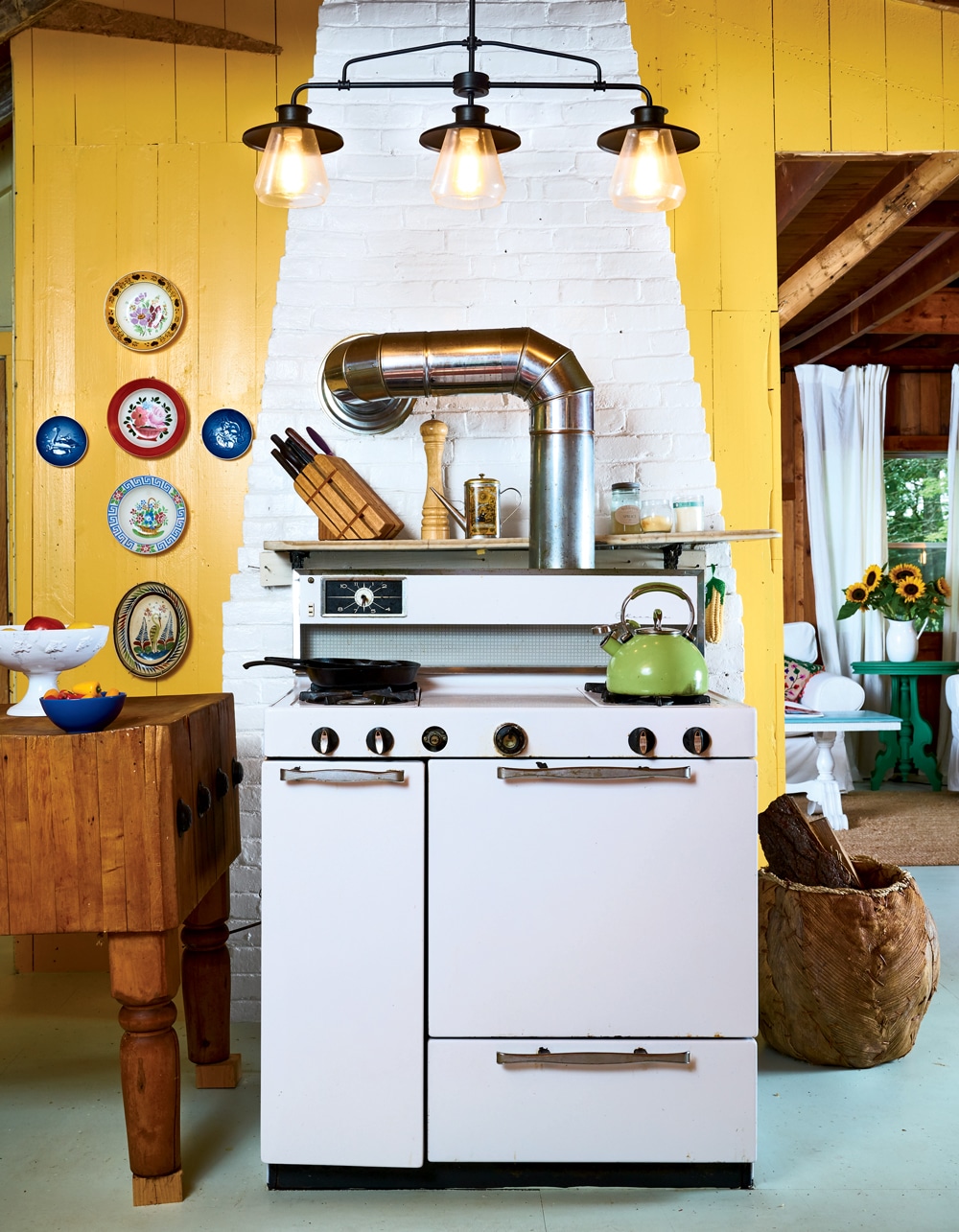
Photo Credit : Photographs by Mark Fleming | Styling by Heather Marcus
At the time the house was listed for sale, the same family had owned it for over 40 years—the first letter of their last name (“F”) attached to the front in an enormous plywood cutout, painted white against the red of the clapboards. The photographs on the real estate listing (which made clear this house had definitely not been staged) featured exactly the kinds of mismatched couches and chairs you’d expect in an old family camp, along with linoleum and curtains that appeared to have been new sometime in the 1950s—right around the time I was born, probably.
Two more things about this house. Though it was hands-down my favorite of any lake house I’d seen, it was also the cheapest by far. And the town where it sat—population roughly 1,400—was just down the road from the very farm stand where I used to buy my corn, back when I lived in New Hampshire, and only a 15-minute drive from where my daughter lived. Three summers earlier—that glorious summer Jim and I rode his motorcycle all around New England—we had stopped at the farm stand just when the Silver Queen corn came ripe, and because we had no saddlebags I’d stuffed my motorcycle jacket with a baker’s dozen to throw into the pot back at our little rented cabin.
Now the Triumph gathered dust, and its driver was fading. Still, when I showed Jim the pictures of my dream New Hampshire lake house, he smiled and said it looked like just our kind of spot, and if we got it, he’d light up a cigar on that porch, and drop his line into the water off the boathouse dock.

Photo Credit : Photographs by Mark Fleming | Styling by Heather Marcus
Our days grew darker. We didn’t leave home much anymore, except to fill prescriptions, and mostly I stayed close to my husband’s side. But once a day, I’d make my way, alone, up to the desk where I no longer did any writing, and click on that real estate listing. I’d memorized every picture by now. I had studied every mismatched dish on the kitchen shelves. Looking at that lake house calmed me down, in my grief.
On New Year’s Eve—5 p.m. California time, 8 p.m. on the East Coast—a thought came to me. What if one day, when I clicked on the real estate listing, my lake house (that’s how I thought of it now) had been sold to someone else?
I didn’t even think more than a minute, just dialed the real estate agent. “I’d like to make an offer on the red lake house with the tower on top and the little boathouse,” I said. Then I quoted a price so far below the asking price (but still so far above what was in my bank account) that I should have blushed.
He got back to me 10 minutes later with the news that his clients had accepted my offer. I made my way downstairs to tell my husband.
“Jimmy,” I said, “I just bought a house on a lake in New Hampshire, just down the road from where we bought the corn.”
My husband’s response was so like him. “That’s great, baby,” he said.
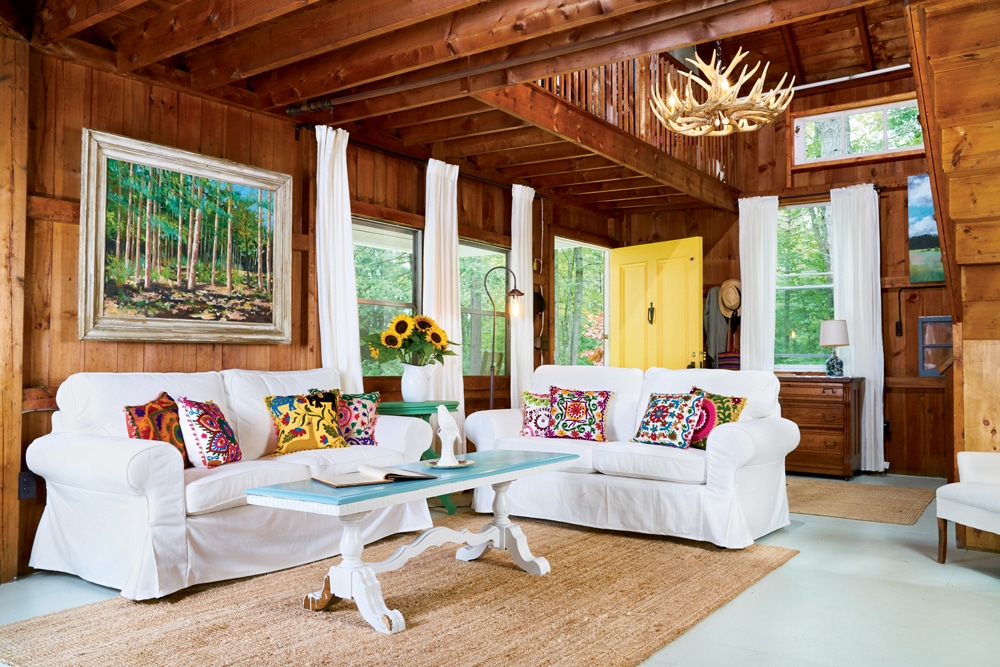
Photo Credit : Photographs by Mark Fleming | Styling by Heather Marcus
Over the months that followed, spending more days at the hospital, caring for Jim, as I scrambled to come up with the down payment, and talked a bank into giving a loan to a woman who’d barely earned a dime in a year, I spoke less and less about the lake house. Jim and I talked once or twice about going there the next summer, but after a while we didn’t mention trout fishing or dinners on the screen porch anymore. We both knew the truth.
I had still not even seen the house in real life—just those pictures on my computer screen—but my friend Danny hiked in through the snow and assured me (though I already knew this) that there was not one thing about this place I wouldn’t love.
Jim died that June. Ten days later, I closed up our house in California and flew back to New Hampshire. Danny picked me up. We headed straight for my lake house.

Photo Credit : Photographs by Mark Fleming | Styling by Heather Marcus
The sun was just going down when we turned off the two-lane blacktop onto the bumpy dirt road where the lake house awaited me. For almost half a mile, no houses, only towering pine trees and a few falling-down old camps.
Then we rounded the last bend, and I saw it. There was the big plywood “F” (later I’d take it down and return it to the previous owners) and the red tower—the smallest widow’s walk you’ve ever seen, but big enough for one medium-size woman to set down one small chair. There was the porch, and around the side, the screen porch, with a row of lilacs, though their bloom was past. There was the clothesline, with a couple of wooden clothespins still clipped on, and a rocking chair, and a tree just right for a hammock.
Down by the water I caught sight of the boathouse, and beyond it, the water dappled in the way it does when trout are feeding. Then came the long, low, mournful call of a single loon.
I set my bags on the grass and looked out at the water. Then headed up the steps to the front door. I put my key in the latch. I was home again.
Read Joyce Maynard’s memoir about falling in love in her late 50s and losing her husband four years later, The Best of Us.


